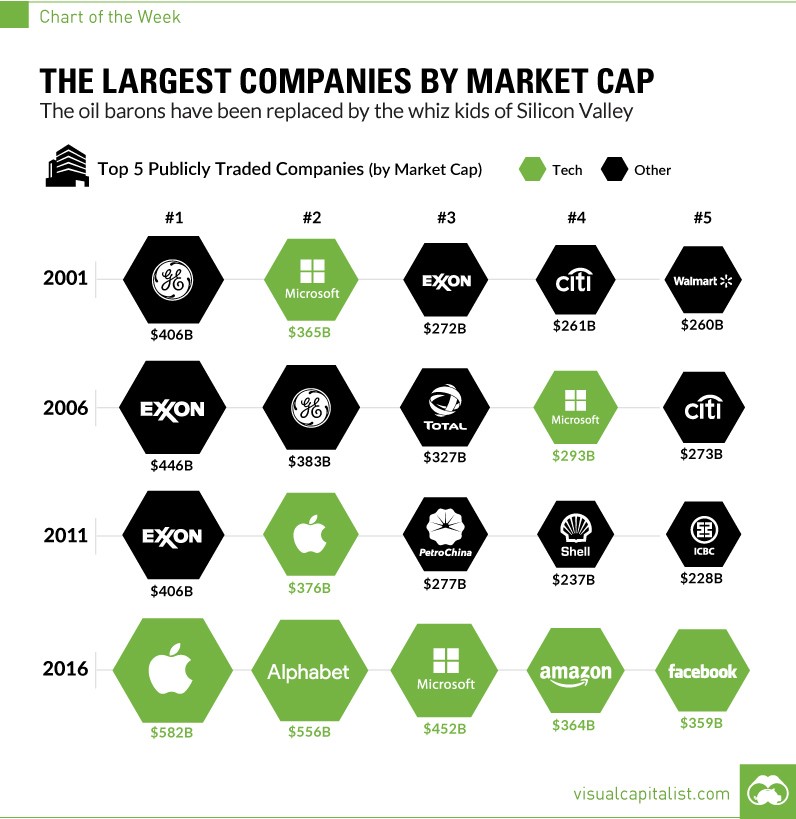Suplari, which announced their $3.1 million funding round today, is our newest investment in an area we helped define – Intelligent Applications. Intelligent Apps combine data and machine learning to provide real-time, actionable insight into business and consumer applications. Going back 4-5 years, we were investing in more horizontal machine learning platforms like Dato/Turi, Algorithmia and MightyAI to help companies combine the talents of their business users, data scientists and programmers to design, text and build intelligent apps. More recently we have been focusing on building vertical or functionally focused intelligent applications including Amperity, Saykara, and Placed.com.
Continue reading “Investing in Suplari – Madrona’s Latest Investment in Intelligent Applications”
Tag: Investment
Xnor.ai – Bringing Deep Learning AI to the Devices at the Edge of the Network
Photo – The Xnor.ai Team
Today we announced our funding of Xnor.ai. We are excited to be working with Ali Farhadi, Mohammad Rastegari and their team on this new company. We are also looking forward to working with Paul Allen’s team at the Allen Institute for AI and in particular our good friend and CEO of AI2, Dr. Oren Etzioni who is joining the board of Xnor.ai. Machine Learning and AI have been a key investment theme for us for the past several years and bringing deep learning capabilities such as image and speech recognition to small devices is a huge challenge.
Mohammad and Ali and their team have developed a platform that enables low resource devices to perform tasks that usually require large farms of GPUs in cloud environments. This, we believe, has the opportunity to change how we think about certain types of deep learning use cases as they get extended from the core to the edge. Image and voice recognition are great examples. These are broad areas of use cases out in the world – usually with a mobile device, but right now they require the device to be connected to the internet so those large farms of GPUs can process all the information your device is capturing/sending and having the core transmit back the answer. If you could do that on your phone (while preserving battery life) it opens up a new world of options.
It is just these kinds of inventions that put the greater Seattle area at the center of the revolution in machine learning and AI that is upon us. Xnor.ai came out of the outstanding work the team was doing at the Allen Institute for Artificial Intelligence (AI2.) and Ali is a professor at the University of Washington. Between Microsoft, Amazon, the University of Washington and research institutes such as AI2, our region is leading the way as new types of intelligent applications takes shape. Madrona is energized to play our role as company builder and support for these amazing inventors and founders.
Every company is a technology company, but most don’t behave like one
In 2011, Marc Andreesen famously wrote a Wall Street Journal essay declaring that “software is eating the world.” Five years later, the five largest companies in the world by market capitalization are all software companies.
However, in today’s information economy, Apple, Alphabet, Microsoft, Amazon, and Facebook are not the only important large technology companies. As technology becomes more and more pervasive across industries and functions, companies like Exxon, GE, Citi, and Walmart are all racing to become technology companies as well.
Today, we are less interested in the distinction between technology and non-technology companies (because there are very few successful companies that are not technology companies). Instead, it’s more interesting to ask questions like – Tesla is a technology company rapidly learning to become an automobile company, and Ford is an automobile company rapidly learning to become a technology company – which one is going to get there first?
In short, software is eating the world, but software companies aren’t the only ones taking a bite.
How do companies in real estate, finance, healthcare, manufacturing, or other industries that have traditionally not been recognized as technology industries become technology companies? What are some of the key learnings that we see from startups and companies that are successfully making this transition?
1. It starts at the highest level of leadership
Leading a transformation to become a successful technology company is not a job that can simply be tasked to the CTO or CIO. The level of engagement and investment to lead a successful transformation requires the CEO and board of directors to not only be fully bought in but to be the main drivers of the change.
Goldman Sachs has known for many years that technology is a key competitive advantage in financial services. In one recent WSJ article, a top Goldman executive valued a license for their risk measurement system at well over $1 billion, and possibly even up to $5 billion. They have since open-sourced the system in a move to attempt to drum up new business. More importantly, however, Goldman Sachs’ Chairman and CEO Lloyd Blankfein has repeatedly stated that “Goldman Sachs is a technology firm” and highlights the fact that Goldman Sachs actually employs more engineers than companies like Facebook, Twitter, or LinkedIn and often competes for talent and wins against top internet companies.
2. Talent is the most important asset of a technology company
One of the key drivers for the rapid growth of new technology companies is the low capital requirement to build a company today. New companies no longer need to buy hundreds of thousands of dollars of servers and equipment; instead, they can pay for servers on demand from cloud providers when needed.
This dynamic makes it more important than ever for companies to hire great people. In fact, a recent survey Madrona conducted in conjunction with its annual CIO Summit found that 89% of Fortune 500 CIOs say hiring top talent is their number one concern today.

GE has likely made the largest investment in this space to change the story that young engineers and college graduates hear about the company with a series of Youtube videos and television ads. Though it remains to be seen whether these videos work, GE has recognized that filling its talent pipeline with young engineers and technologists is critical and is investing accordingly.
3. Technology needs to be at the core of company culture, not an afterthought
At a company like Microsoft or Facebook, engineering positions are the most prestigious, highest status roles at the company. The founders and CEOs of technology companies are often engineers and may have even built early version of the products themselves.
For companies to successfully make the transition to become a technology company, cultures need to change to take into account the unique way that software development works and to highlight the importance of technology and the people who manage and build it.
One example of a move towards a developer friendly culture is happening at Walmart. WalmartLabs recently open sourced Electrode, the application platform that powers Walmart.com. Electrode is a modular platform that helps improve application performance, and Walmart is open sourcing the software to give back to the open source world and benefit from additional contributions from the community.
It is important to keep in mind that building a technology-driven culture is not just about free lunches and massages. As Joel Spolsky CEO of Stack Overflow said in a recent interview, “If you want to attract and keep developers, don’t emphasize ping-pong tables, lounges, fire pits and chocolate fountains. Give them private offices or let them work from home, because uninterrupted time to concentrate is the most important and scarcest commodity.”
4. Companies need to move fast and adopt agile practices
The pace of technology adoption is getting faster and faster every year. For example, it took decades for electricity and telephones to reach 50% of US households, but today it takes only years for new technologies like smartphones and tablets to reach a majority of the population. This underscores the importance for companies to continuously adopt new technologies that can enhance productivity and also to continuously experiment with new technologies that have the potential to be disruptive to the business.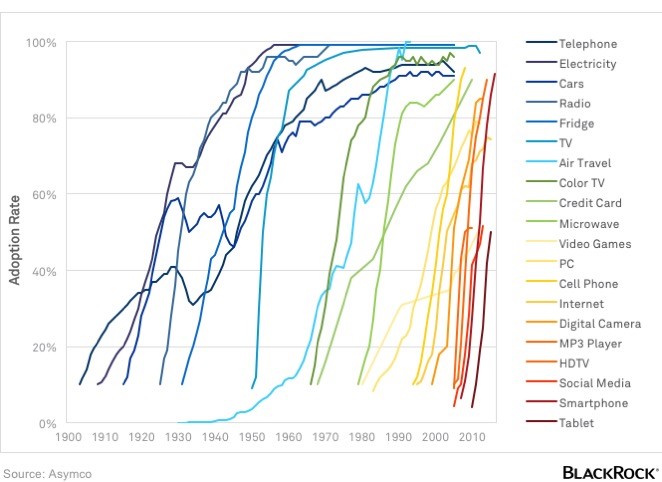
An interesting anecdote from The Lean Startup, one of the manifestos for startup founders, is that Intuit holds themselves accountable to being innovative and agile by using two key metrics: (1) the number of customers using products that didn’t exist three years ago and (2) the percentage of revenue coming from offerings that did not exist three years ago. Historically for Intuit, it took a new product an average of 5.5 years to reach $50 million in revenue; at the time the book was written, they had multiple products generating $50 million in revenue that were less than a year old.
Particularly, as the world is moving towards cloud computing, continuous development and continuous updates are the name of the game. Agile development practices enable you to continuously deliver better experiences for your customers and waterfall development methodology is a relic of the past.
5. Companies need to look forward and avoid getting caught in the innovator’s dilemma
The classic case for why legacy competitors can do everything “right” and fail is the force of disruptive innovation described in Clayton Christensen’s The Innovator’s Dilemma. Businesses can reject innovations based on customers’ current needs while innovative upstarts develop products in a way that meets customers’ future needs.
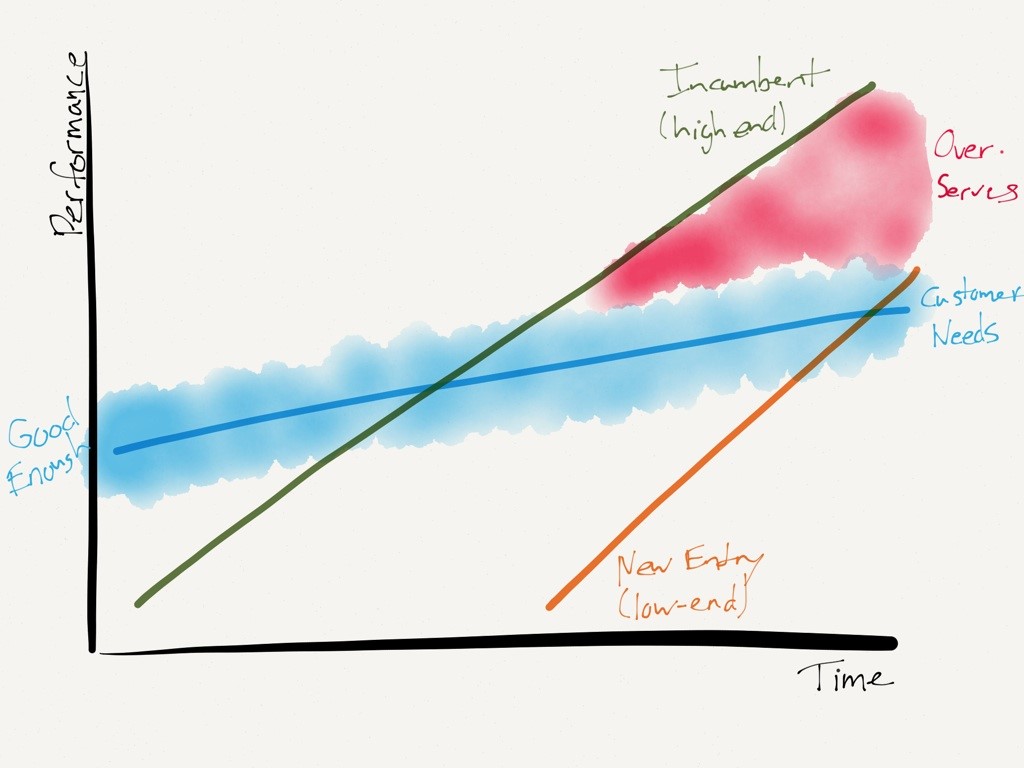
Recently, we have seen automakers take very innovative approaches to automotive technology as autonomous vehicles move to the front and center of the startup world with the acquisitions of companies like Otto and Cruise and public pilots of new technologies like Uber’s self-driving cars in Pittsburgh or Tesla’s Autopilot feature.
Ford, in particular, has been very vocal about the autonomous future and the importance of working differently in the context of today’s technology-driven world. Ford’s CEO, Mark Fields, has written that “As little as four years ago, our approach was aligned with the thinking of most automakers today, which is taking incremental steps to achieve full autonomy by advancing driver assist technology. This is not how we look at it today. We learned that to achieve full autonomy, we’d have to take a completely different pathway.”
Conclusion
The race to become the market leader across a variety of sectors and geographies is speeding up amongst older incumbents and promising, young startups. Startups have a lot to learn from the established management and financial practices of incumbents, but incumbents have a lot to learn from startups as well. The companies, young or old, that use technology to best create competitive advantages for themselves will win.
Technology needs to be a fundamental fabric of the company’s DNA and culture as companies truly internalize that “Every company is a technology company”.
Why We Invested in Heptio
We could not be more excited to be investing in Heptio. Heptio is aiming to become the Kubernetes company and is founded by two of the creators of Kubernetes at Google, Craig McLuckie and Joe Beda. Specifically, Kubernetes is the leading open source cluster manager for containers; but, broadly, we feel Kubernetes is a core technology that is changing how IT in enterprises works. Joe and Craig are two world class entrepreneurs who have the technological expertise, the industry and customer relationships, and the leadership and respect of the Kubernetes community necessary to build a massively successful business in this field. Heptio also represents an investment in one of the biggest themes Madrona has been tracking over the past several years: the move to “Cloud Native.”
Over the past decade plus, we have seen enterprises steadily evolve towards a cloud native world.
Over the past decade plus, we have seen enterprises steadily evolve towards a cloud native world. This movement began with application workloads moving from operating systems running on bare metal servers to virtual machines running on hypervisors, primarily to reduce cost by consolidating hardware. Then we saw the move of these virtual machines into the cloud to greatly increase operational agility and further reduce cost. This enormous move (of which we are still in the relatively early innings), led first by Amazon Web Services as well as Microsoft Azure, turned Seattle into the Cloud Capital of the world. While much of this move to the cloud has meant migrating from on-premise to a public cloud infrastructure, enterprises have also altered their approach to internal infrastructure and created private clouds to capture many of the same advantages of the public cloud. This brings us to cloud native – the current wave of the cloud evolution that is really a combination of technologies, practices and culture.
The cloud native technological shifts that are occurring are accelerating adoption of containers (usually replacing VM’s but also running inside them) and application architectures moving to distributed microservices. All of this requires a different approach to working and managing resources, often referred to as DevOps, but perhaps better described as “cloud native ops.” The advantages of this approach are many: further reduced cost and complexity, greater developer productivity, easier to manage and scale applications, and better performance – all without sacrificing security. Now, as containers and microservices proliferate, managing them and the server clusters they run on at scale has created new challenges. Thus, Madrona and many VC investors have been hunting for and investing in companies that make it easier to orchestrate, network, secure, monitor, and attach storage to container-based, microservice architectures.
However, orchestration and management are the most strategic capabilities needed by enterprises for these container-based, cloud native environments. Docker is a company that has become one of the better known names in IT because of their container technology and its widespread popularity with developers. Now Docker is also offering and attempting to monetize their orchestration software. Google has been the leader in developing and managing container-based applications and infrastructure far longer than Docker. In February 2015, Google released Kubernetes as an enterprise-friendly open source project that encapsulated a decade of experience building their internal container-based cluster management system called Borg, which is the core of how Google manages their datacenters. Then in July 2015 when Kubernetes hit version 1.0, Google donated control of the project to the Cloud Native Computing Foundation. While everyone in this industry knows Docker and has heard of Kubernetes, what you might not know is that Kubernetes is now the most active project on Github.
Further, the most popular way to manage and orchestrate Docker containers is not actually Docker. It’s Kubernetes. While many chapters in this story certainly remain to be written, we feel that Kubernetes is the key platform technology for this continuing evolution to cloud native and is on a path to be the default management system for this new way of computing. This is a hugely valuable opportunity, and Heptio can be the go-to partner for cloud native enterprise IT transformation.
We feel that Kubernetes is the key platform technology for this continuing evolution to cloud native and is on a path to be the default management system for this new way of computing.
In the world of start-ups, it’s not enough to just have a great idea and a big market. You have to have the right team. And Craig and Joe are literally the best team in the world to go after this opportunity. As Kubernetes co-creators here in Google’s Seattle offices, they understand the space inside and out, know and are known by the Kubernetes open source community, and have a deep appreciation for the users of Kubernetes and the challenges faced by enterprise customers in adopting this technology. You could say that the founders of Kubernetes are carrying on the mission as a stand-alone company.
While Kubernetes has become very popular, it is still too difficult to get up and running. Companies also have nowhere to turn to get enterprise-level support, which is a necessity for broad corporate IT adoption. Heptio will provide this commercial support, while also building on the open source base to improve usability, installation, and eventually adding and extending Kubernetes features and functionality. They will do this in a way that supports the existing ecosystem, not competes with it. Over time, we think Heptio can become a centerpiece for how companies develop and operate software.
We are also pleased to be partnering with Ping Li from Accel, who led the investment round, in our support of Heptio.
At Madrona, we aim to invest in the best entrepreneurs attacking the biggest markets in the Pacific NW, who have the opportunity and ambition to build long-term, standalone businesses. We feel that Heptio can be the next iconic cloud company based here in Seattle, and we are excited to help Craig and Joe along this journey.
Why Madrona Invested in Accolade
World-class teams, compelling problems to solve and sustainably differentiated solutions. These are ingredients for a promising venture investment. At Madrona, we usually focus on early-stage companies that are differentiated through information technology and based in the Pacific Northwest. We believe, now more than ever, our strategy will help build a next-generation of leading companies in the region.
So, why did Madrona participate for the first time in the Series E round of Accolade? Accolade is an on-demand healthcare concierge for employers, health plans, health systems and the people they serve. Founded nine years ago in Pennsylvania, the company attracted Raj Singh as CEO last year. Raj has already brought together a strong group of existing executives with some former Concur executives, including CTO Mike Hilton, to build the world-class Accolade leadership team based primarily in Seattle.
We believe, now more than ever, our strategy will help build a next-generation of leading companies in the region.
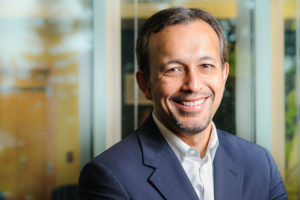
Raj and Mike co-founded Concur in 1993 before Madrona even existed and played leadership roles throughout, culminating in an $8.3 billion sale to SAP in 2014. Madrona has maintained a close working relationship with many members of the Concur executive team. Raj is on the board of Madrona-backed companies Apptio and Amperity. We have seen first-hand the value Raj and Mike provide entrepreneurs in operationally scaling companies. They are experts at applying innovative technologies to improve customer experiences in a cost-effective manner.
. . . the Accolade team has the opportunity to be a very large player in the evolving healthcare landscape.
Healthcare is a massive market and Accolade has many opportunities to apply mobile and data-driven capabilities to their existing concierge solutions and scale their personalized service to more healthcare consumers. As the healthcare industry continues to evolve to an outcome-per-patient model with increased use of medical records and data, patients need guidance and advice more than ever. With technology enabled services, employers and their families can make better health care choices benefitting their own lives. Accolade has a distinct model for remaining people-centered while leveraging modern technologies and techniques.
We believe the Accolade team has the opportunity to be a very large player in the evolving healthcare landscape. By doing so, they can build another leading technology company here in Seattle. And, we have found that Madrona can add the most value when teams are based in region. The combination of a proven, Seattle-based team and a compelling business model convinced us that investing at a later stage in Accolade was the right fit.
Our Investment in Shyft – Transforming the Lives of Hourly Shift Workers
It is exciting and super fun for me to announce our seed investment in Shyft and to welcome the team to our Madrona family.
Shyft serves the huge market of shift workers worldwide – from retail to food service and beyond. They make it very easy for these hourly workers to find someone to cover a shift. It is a real time communication system that has been broadly embraced by users. Workers at 1/3 of Starbucks’ U.S. locations are already on the platform – all driven bottoms up rather than top down.
I first had the opportunity to meet Brett Patrontasch (CEO) and Daniel Chen (CTO) as a part of the most recent TechStars Seattle class. Right from my first interaction, Brett and Daniel were very impressive. Their first company approached this market from a different angle and they learned a lot. They were brave enough to shut it down and take what they learned to build something better. Brett has a strong conviction about this market and is eager to leverage the expertise of his advisors.
Madrona is investing in this seed round because we like the team, see the massive market opportunity and are impressed by their early growth. Shyft’s viral adoption and growth is impressive. For example, Starbucks has hourly workers in their stores on Shyft actively trading shifts each day. One person from McDonald’s tried the app and a day later 70 of her co-workers were on the platform. And though Shyft is primarily focused on workers, store managers are already starting to use the product as having a full staff is crucial for them.
I fundamentally believe that Shyft can build a massive platform and community for hourly shift workers. The app is a game-changing way for hourly workers and managers to coordinate with one another and manage their busy schedules. The mobile first approach speaks directly to the majority of this hourly smartphone-wielding audience.
This is the 5th company we have backed from the Seattle TechStars program. TechStars and all the people who run and support it are an incredibly important part of the Seattle ecosystem that brings together great founders, angel and VC investors and experienced operators. We are glad it is here and love participating.
I am looking forward to working with Brett, Daniel and the Shyft team as they build their team and business.
Why We Invested in Wrench
I am incredibly excited to be working with Ed and his team at Wrench and today we are announcing an investment in their Series Seed fundraise. I have known Ed for awhile and we started talking early about his vision and conviction for changing a big market – auto repair.
When I was a kid my dad and many other parents could fix cars. Changing the oil, replacing air/oil filters, fan belts, spark plugs and other things were commonly done by car owners. Somewhere over the last 40 years cars got harder to fix or people became more nervous about dealing with their cars.
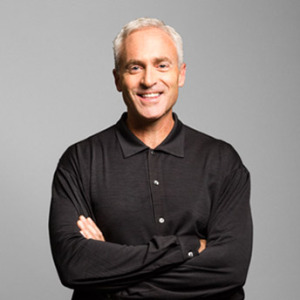 There are more than 120 million cars on the road that are three years or older and the repairs on those vehicles run to $57 billion annually. I personally have a couple of these in my household and believe the day Ed and I first talked about his plan to deliver car repair to consumers I had spent too many frustrating hours at the repair shop. Wrench delivers the service to you – where your car is. A bunch of folks at Madrona and in our network used the service and loved it. Those were not singular experiences – they have happy customers all over the city.
There are more than 120 million cars on the road that are three years or older and the repairs on those vehicles run to $57 billion annually. I personally have a couple of these in my household and believe the day Ed and I first talked about his plan to deliver car repair to consumers I had spent too many frustrating hours at the repair shop. Wrench delivers the service to you – where your car is. A bunch of folks at Madrona and in our network used the service and loved it. Those were not singular experiences – they have happy customers all over the city.
Ed and his experienced team who worked together at Talentwise and Intelius have come together to tackle an ambitious plan to disrupt a market that hasn’t changed in decades. Wrench takes a brick and mortar industry and leverages mobile, cloud, advanced analytics and supply chain efficiencies to bring a service to market that resonates with anyone who owns an older car. As an investor the Wrench team has what we look for in early stage funding – a great team, a big idea, and a big market.
I am happy to be along for the ride and support this team!
